Structure, Mechanical and Tribological Properties of Me-Doped Diamond-Like Carbon (DLC) (Me = Al, Ti, or Nb) Hydrogenated Amorphous Carbon Coatings
Abstract
1. Introduction
2. Experimental Details
2.1. Coatings Deposition
2.2. Composition and Structure Characterizations
2.3. Mechanical Properties
2.4. Friction and Wear Testing
3. Results and Discussion
3.1. Chemical Composition and Structure
3.1.1. Chemical Composition
3.1.2. Structure
3.2. Mechanical Properties
3.2.1. Residual Stress
3.2.2. Hardness and Young’s Modulus
3.3. Tribological Performances
4. Conclusions
Author Contributions
Funding
Conflicts of Interest
References
- Robertson, J. Diamond-like amorphous carbon. Mater. Sci. Eng. R Rep. 2002, 37, 129–281. [Google Scholar] [CrossRef]
- Serbezov, V.; Reifart, N.; Herbst, F. DLC films for stent applications. In Proceedings of the 2009 3rd ICTON Mediterranean Winter Conference, Angers, France, 10–12 December 2009; IEEE: Piscataway, NJ, USA, 2010; pp. 1–6. [Google Scholar]
- Hauert, R. A review of modified DLC coatings for biological applications. Diam. Relat. Mater. 2003, 12, 583–589. [Google Scholar] [CrossRef]
- Hauert, R.; Thorwarth, K.; Thorwarth, G. An overview on diamond-like carbon coatings in medical applications. Surf. Coat. Technol. 2013, 233, 119–130. [Google Scholar] [CrossRef]
- Dearnaley, G.; Arps, J.H. Biomedical applications of diamond-like carbon (DLC) coatings: A review. Surf. Coat. Technol. 2005, 200, 2518–2524. [Google Scholar] [CrossRef]
- Roy, R.K.; Lee, K.R. Biomedical applications of diamond-like carbon coatings: A review. J. Biomed. Mater. Res. B Appl. Biomater. 2007, 83B, 72–84. [Google Scholar] [CrossRef] [PubMed]
- Ohgoe, Y.; Hirakuri, K.K.; Saitoh, H.; Nakahigashi, T.; Ohtake, N.; Hirata, A.; Kanda, K.; Hiratsuka, M.; Fukui, Y. Classification of DLC films in terms of biological response. Surf. Coat. Technol. 2012, 207, 350–354. [Google Scholar] [CrossRef]
- Love, C.A.; Cook, R.B.; Harvey, T.J.; Dearnley, P.A.; Wood, R.J.K. Diamond like carbon coatings for potential application in biological implants—A review. Tribol. Int. 2013, 63, 141–150. [Google Scholar] [CrossRef]
- Grill, A. Diamond-like carbon coatings as biocompatible materials—An overview. Diam. Relat. Mater. 2003, 12, 166–170. [Google Scholar] [CrossRef]
- Li, K.Y.; Zhou, Z.F.; Chan, C.Y.; Bello, I.; Lee, C.S.; Lee, S.T. Mechanical and tribological properties of diamond-like carbon films prepared on steel by ECR-CVD process. Diam. Relat. Mater. 2001, 10, 1855–1861. [Google Scholar] [CrossRef]
- Shahsavari, F.; Ehteshamzadeh, M.; Naimi-Jamal, M.R.; Irannejad, A. Nanoindentation and nanoscratch behaviors of DLC films growth on different thickness of Cr nanolayers. Diam. Relat. Mater. 2016, 70, 76–82. [Google Scholar] [CrossRef]
- Lai, K.H.; Chan, C.Y.; Fung, M.K.; Bello, I.; Lee, C.S.; Lee, S.T. Mechanical properties of DLC films prepared in acetylene and methane plasmas using electron cyclotron resonance microwave plasma chemical vapor deposition. Diam. Relat. Mater. 2001, 10, 1862–1867. [Google Scholar] [CrossRef]
- Huang, L.; Lu, J.; Xu, K. Elasto-plastic deformation and fracture mechanism of a diamond-like carbon film deposited on a Ti–6Al–4V substrate in nano-scratch test. Thin Solid Films 2004, 466, 175–182. [Google Scholar] [CrossRef]
- Donnet, C.; Grill, A. Friction control of diamond-like carbon coatings. Surf. Coat. Technol. 1997, 94–95, 456–462. [Google Scholar] [CrossRef]
- Vengudusamy, B.; Mufti, R.A.; Lamb, G.D.; Green, J.H.; Spikes, H.A. Friction properties of DLC/DLC contacts in base oil. Tribol. Int. 2011, 44, 922–932. [Google Scholar] [CrossRef]
- Tillmann, W.; Vogli, E.; Hoffmann, F. Wear-resistant and low-friction diamond-like-carbon (DLC)-layers for industrial tribological applications under humid conditions. Surf. Coat. Technol. 2009, 204, 1040–1045. [Google Scholar] [CrossRef]
- Erdemir, A.; Donnet, C. Tribology of diamond-like carbon films: Recent progress and future prospects. J. Phys. D Appl. Phys. 2006, 39, R311. [Google Scholar] [CrossRef]
- Field, S.K.; Jarratt, M.; Teer, D.G. Tribological properties of graphite-like and diamond-like carbon coatings. Tribol. Int. 2004, 37, 949–956. [Google Scholar] [CrossRef]
- Escudeiro, A.; Polcar, T.; Cavaleiro, A. Tribological behaviour a-C and a-C:H films doped with Ti in biological solutions. Vacuum 2011, 85, 1144–1148. [Google Scholar] [CrossRef]
- Liu, H.; Tanaka, A.; Umeda, K. The tribological characteristics of diamond-like carbon films at elevated temperatures. Thin Solid Films 1999, 346, 162–168. [Google Scholar] [CrossRef]
- Chouquet, C.; Gerbaud, G.; Bardet, M.; Barrat, S.; Billard, A.; Sanchette, F.; Ducros, C. Structural and mechanical properties of a-C:H and Si doped a-C:H thin films grown by LF-PECVD. Surf. Coat. Technol. 2010, 204, 1339–1346. [Google Scholar] [CrossRef]
- Chouquet, C.; Ducros, C.; Barrat, S.; Billard, A.; Sanchette, F. Mechanical properties of a-C:H/Si containing a-C:H multilayered coatings grown by LF-PECVD. Surf. Coat. Technol. 2008, 203, 745–749. [Google Scholar] [CrossRef]
- Butt, M.Z.; Khaleeq-ur-Rahman, M.; Ali, D.; Akmal, A.; Naseem, S. Deposition and characterization of multilayer DLC: Mo thin films grown on silicon substrate by off-axis pulsed laser deposition technique. Appl. Surf. Sci. 2015, 331, 407–414. [Google Scholar] [CrossRef]
- Mutafov, P.; Lanigan, J.; Neville, A.; Cavaleiro, A.; Polcar, T. DLC-W coatings tested in combustion engine —Frictional and wear analysis. Surf. Coat. Technol. 2014, 260, 284–289. [Google Scholar] [CrossRef]
- Cooper, C.V.; Wang, R.; Yoon, H.K.; Taher, M.A. The microstructure and wear behavior of Cr- and W-DLC coatings sputter-deposited onto AISI 52100 substrates as elucidated using focused-ion-beam SEM. MRS Online Proc. Libr. Arch. 2001, 697. [Google Scholar] [CrossRef]
- Roth, D.; Rau, B.; Roth, S.; Mai, J.; Dittrich, K.H. Large area and three-dimensional deposition of diamond-like carbon films for industrial applications. Surf. Coat. Technol. 1995, 74–75, 637–641. [Google Scholar] [CrossRef]
- Dimigen, H.; Hübsch, H.; Memming, R. Tribological and electrical properties of metal-containing hydrogenated carbon films. Appl. Phys. Lett. 1987, 50, 1056–1058. [Google Scholar] [CrossRef]
- Donnet, C. Recent progress on the tribology of doped diamond-like and carbon alloy coatings: A review. Surf. Coat. Technol. 1998, 100–101, 180–186. [Google Scholar] [CrossRef]
- Voevodin, A.A.; Prasad, S.V.; Zabinski, J.S. Nanocrystalline carbide/amorphous carbon composites. J. Appl. Phys. 1997, 82, 855–858. [Google Scholar] [CrossRef]
- Lee, K.R.; Eun, K.Y.; Kim, K.M.; Choi, K.C. Application of diamond-like carbon films for anti-abrasion and low friction properties of VCR head drums. Surf. Coat. Technol. 1995, 76–77, 786–790. [Google Scholar] [CrossRef]
- Cui, J.; Qiang, L.; Zhang, B.; Ling, X.; Yang, T.; Zhang, J. Mechanical and tribological properties of Ti-DLC films with different Ti content by magnetron sputtering technique. Appl. Surf. Sci. 2012, 258, 5025–5030. [Google Scholar] [CrossRef]
- Ma, G.; Gong, S.; Lin, G.; Zhang, L.; Sun, G. A study of structure and properties of Ti-doped DLC film by reactive magnetron sputtering with ion implantation. Appl. Surf. Sci. 2012, 258, 3045–3050. [Google Scholar] [CrossRef]
- Qiang, L.; Gao, K.; Zhang, L.; Wang, J.; Zhang, B.; Zhang, J. Further improving the mechanical and tribological properties of low content Ti-doped DLC film by W incorporating. Appl. Surf. Sci. 2015, 353, 522–529. [Google Scholar] [CrossRef]
- Yang, W.J.; Sekino, T.; Shim, K.B.; Niihara, K.; Auh, K.H. Deposition and microstructure of Ti-containing diamond-like carbon nanocomposite films. Thin Solid Films 2005, 473, 252–258. [Google Scholar] [CrossRef]
- Jo, Y.J.; Zhang, T.F.; Son, M.J.; Kim, K.H. Synthesis and electrochemical properties of Ti-doped DLC films by a hybrid PVD/PECVD process. Appl. Surf. Sci. 2018, 433, 1184–1191. [Google Scholar] [CrossRef]
- Dai, W.; Zheng, H.; Wu, G.; Wang, A. Effect of bias voltage on growth property of Cr-DLC film prepared by linear ion beam deposition technique. Vacuum 2010, 85, 231–235. [Google Scholar] [CrossRef]
- Dai, W.; Ke, P.; Wang, A. Microstructure and property evolution of Cr-DLC films with different Cr content deposited by a hybrid beam technique. Vacuum 2011, 85, 792–797. [Google Scholar] [CrossRef]
- Amanov, A.; Watabe, T.; Tsuboi, R.; Sasaki, S. Fretting wear and fracture behaviors of Cr-doped and non-doped DLC films deposited on Ti–6al–4V alloy by unbalanced magnetron sputtering. Tribol. Int. 2013, 62, 49–57. [Google Scholar] [CrossRef]
- Mercer, C.; Evans, A.G.; Yao, N.; Allameh, S.; Cooper, C.V. Material removal on lubricated steel gears with W-DLC-coated surfaces. Surf. Coat. Technol. 2003, 173, 122–129. [Google Scholar] [CrossRef]
- Baba, K.; Hatada, R.; Tanaka, Y. Preparation and properties of W-containing diamond-like carbon films by magnetron plasma source ion implantation. Surf. Coat. Technol. 2007, 201, 8362–8365. [Google Scholar] [CrossRef]
- Dai, W.; Wang, A. Deposition and properties of Al-containing diamond-like carbon films by a hybrid ion beam sources. J. Alloy. Compd. 2011, 509, 4626–4631. [Google Scholar] [CrossRef]
- Dai, W.; Ke, P.; Wang, A. Influence of bias voltage on microstructure and properties of Al-containing diamond-like carbon films deposited by a hybrid ion beam system. Surf. Coat. Technol. 2013, 229, 217–221. [Google Scholar] [CrossRef]
- Zhou, S.; Wang, L.; Xue, Q. The structure and tribological properties of aluminum/carbon nanocomposite thin films synthesized by reactive magnetron sputtering. Surf. Interface Anal. 2011, 43, 1057–1063. [Google Scholar] [CrossRef]
- Meškinis, Š.; Gudaitis, R.; Vasiliauskas, A.; Čiegis, A.; Šlapikas, K.; Tamulevičius, T.; Andrulevičius, M.; Tamulevičius, S. Piezoresistive properties of diamond like carbon films containing copper. Diam. Relat. Mater. 2015, 60, 20–25. [Google Scholar] [CrossRef]
- Dai, W.; Wang, A.; Wang, Q. Microstructure and mechanical property of diamond-like carbon films with ductile copper incorporation. Surf. Coat. Technol. 2015, 272, 33–38. [Google Scholar] [CrossRef]
- Corbella, C.; Vives, M.; Pinyol, A.; Bertran, E.; Canal, C.; Polo, M.C.; Andújar, J.L. Preparation of metal (W, Mo, Nb, Ti) containing a-C:H films by reactive magnetron sputtering. Surf. Coat. Technol. 2004, 177–178, 409–414. [Google Scholar] [CrossRef]
- Bouabibsa, I.; Lamri, S.; Alhussein, A.; Minea, T.; Sanchette, F. Plasma investigations and deposition of metal doped Me-DLC (Me = Al, Ti or Nb) obtained by a magnetron sputtering-RFPECVD hybrid process. Surf. Coat. Technol. 2018, 354, 351–359. [Google Scholar] [CrossRef]
- Stoney, G.G. The tension of metallic films deposited by electrolysis. Proc. R. Soc. Lond. A 1909, 82, 172–175. [Google Scholar] [CrossRef]
- Fanchon, J.L. Guide de Mécanique: Sciences et Technologies Industrielles, Statique, Cinématique, Dynamique, Résistance des Matériaux, Élasticité, Mécanique des Fluides, Vibrations; Nathan: Paris, France, 2006. (In French) [Google Scholar]
- Schiffmann, K.I.; Fryda, M.; Goerigk, G.; Lauer, R.; Hinze, P.; Bulack, A. Sizes and distances of metal clusters in Au-, Pt-, W- and Fe-containing diamond-like carbon hard coatings: A comparative study by small angle X-ray scattering, wide angle X-ray diffraction, transmission electron microscopy and scanning tunnelling microscopy. Thin Solid Films 1999, 347, 60–71. [Google Scholar]
- Voevodin, A.A.; O’neill, J.P.; Zabinski, J.S. WC/DLC/WS2 nanocomposite coatings for aerospace tribology. Tribol. Lett. 1999, 6, 75–78. [Google Scholar] [CrossRef]
- Ihara, H.; Kumashiro, Y.; Itoh, A.; Maeda, K. Some aspects of ESCA spectra of single crystals and thin films of titanium carbide. Jpn. J. Appl. Phys. 1973, 12, 1462. [Google Scholar] [CrossRef]
- Gonbeau, D.; Guimon, C.; Pfister-Guillouzo, G.; Levasseur, A.; Meunier, G.; Dormoy, R. XPS study of thin films of titanium oxysulfides. Surf. Sci. 1991, 254, 81–89. [Google Scholar] [CrossRef]
- Casamassima, M. Caracterisation des Proprietes Acide-Base des Surfaces d’Oxydes d’Aluminium et de Silicium en Vue de la Comprehension des Mecanismes d’Adhesion Avec un Mastic Silicone. Ph.D. Thesis, ENMP, Paris, France, 1991. (In French). [Google Scholar]
- Pashutski, A.; Folman, M. Low temperature XPS studies of NO and N2O adsorption on Al(100). Surf. Sci. 1989, 216, 395–408. [Google Scholar] [CrossRef]
- Yadav, V.S.; Sahu, D.K.; Singh, M.; Kumar, K. Study of Raman spectra of nano-crystalline diamond like carbon (DLC) films composition (sp2:sp3) with substrate temperature. In Proceedings of the World Congress on Engineering and Computer Science, San Francisco, CA, USA, 20–22 October 2009; pp. 78–81. [Google Scholar]
- Ferrari, A.C.; Robertson, J. Resonant Raman spectroscopy of disordered, amorphous, and diamondlike carbon. Phys. Rev. B 2001, 64, 075417. [Google Scholar] [CrossRef]
- Ferrari, A.C. Determination of bonding in diamond-like carbon by Raman spectroscopy. Diam. Relat. Mater. 2002, 11, 1053–1061. [Google Scholar] [CrossRef]
- Irmer, G.; Dorner-Reisel, A. Micro-Raman Studies on DLC coatings. Adv. Eng. Mater. 2005, 7, 694–705. [Google Scholar] [CrossRef]
- Ferrari, A.C.; Robertson, J. Interpretation of Raman spectra of disordered and amorphous carbon. Phys. Rev. B 2000, 61, 14095–14107. [Google Scholar] [CrossRef]
- Beeman, D.; Silverman, J.; Lynds, R.; Anderson, M.R. Modelling studies of amorphous carbon. Phys. Rev. B 1984, 30, 870–875. [Google Scholar] [CrossRef]
- Robertson, J. Properties and prospects for non-crystalline carbons. J. Non-Cryst. Solids 2002, 299–302, 798–804. [Google Scholar] [CrossRef]
- Choi, J.H.; Ahn, H.S.; Lee, S.C.; Lee, K.R. Stress reduction behavior in metal-incorporated amorphous carbon films: First-principles approach. J. Phys. Conf. Ser. 2006, 29, 155. [Google Scholar] [CrossRef]
- Sonoda, T.; Nakao, S.; Ikeyama, M. Deposition of Ti/C nano-composite DLC films by magnetron DC sputtering with dual targets. Vacuum 2009, 84, 666–668. [Google Scholar] [CrossRef]
- Polcar, T.; Vitu, T.; Cvrcek, L.; Novak, R.; Vyskocil, J.; Cavaleiro, A. Tribological behaviour of nanostructured Ti-C:H coatings for biomedical applications. Solid State Sci. 2009, 11, 1757–1761. [Google Scholar] [CrossRef]

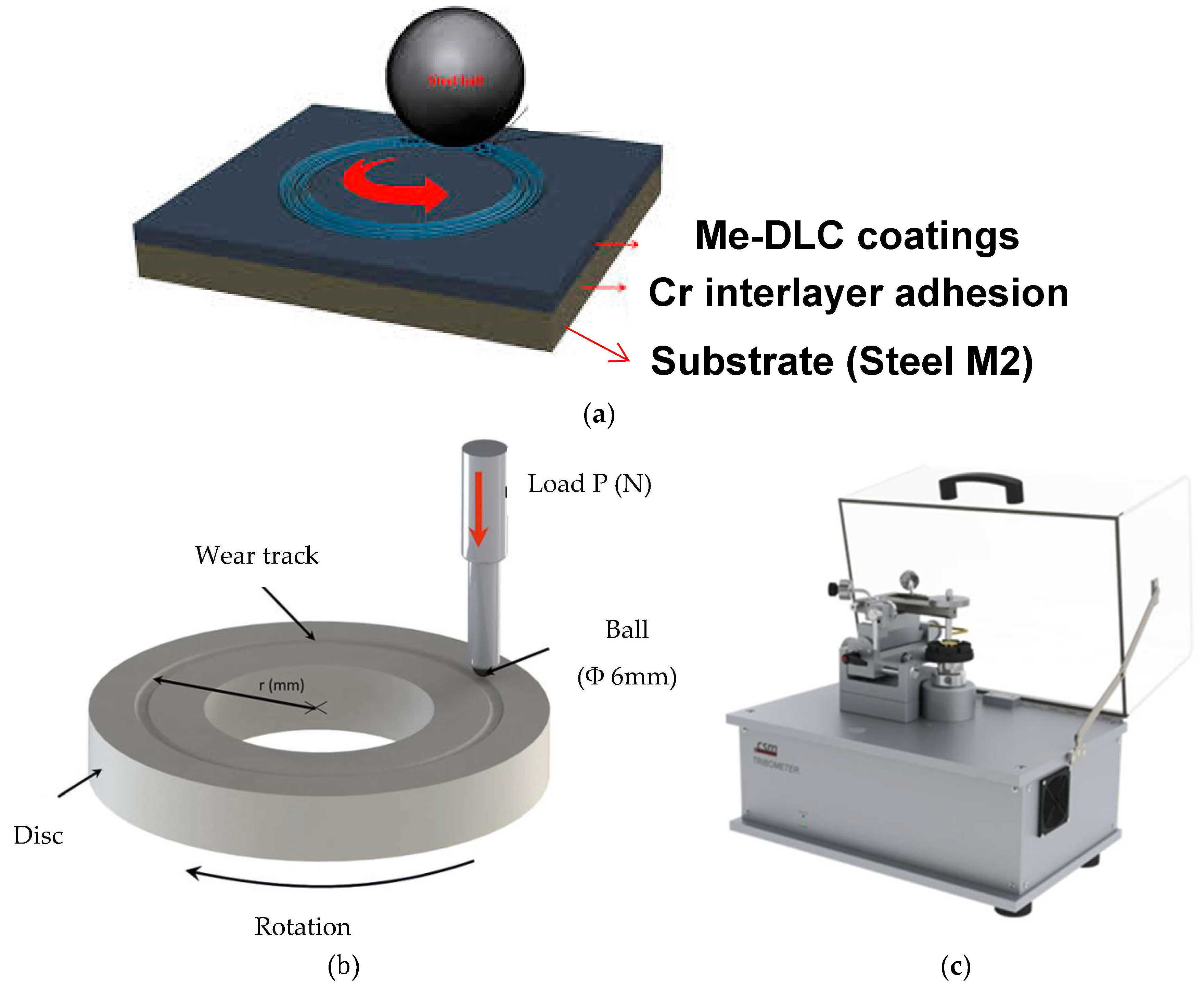

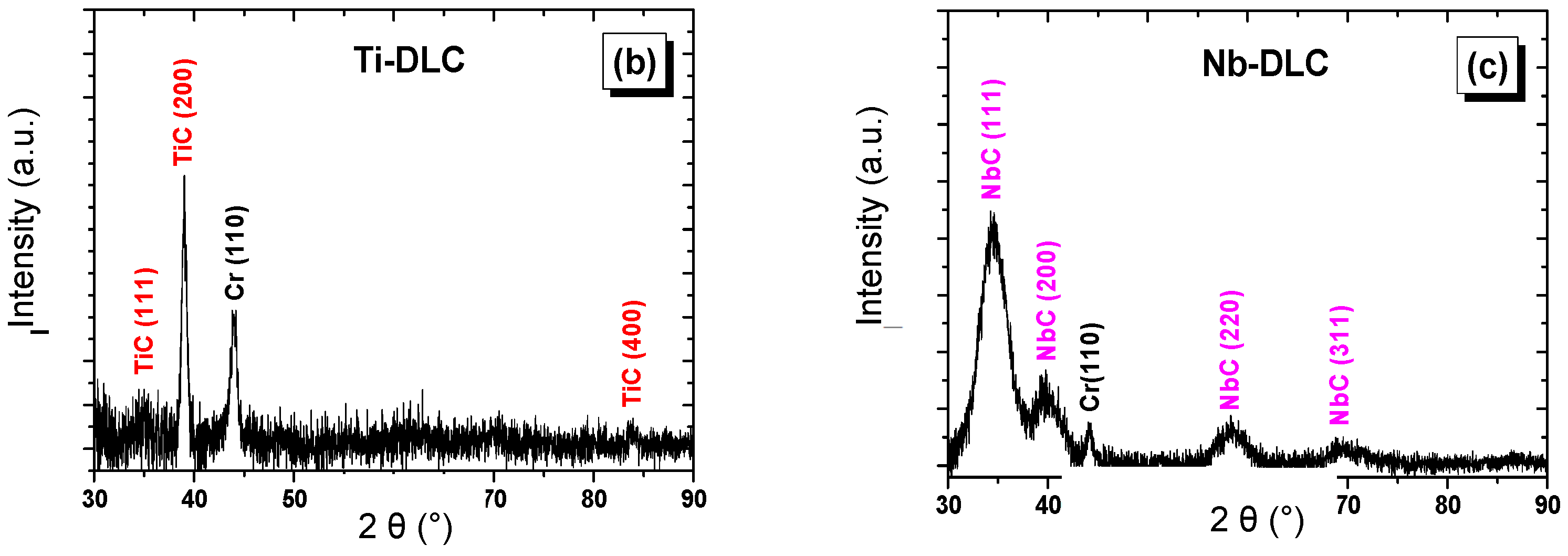
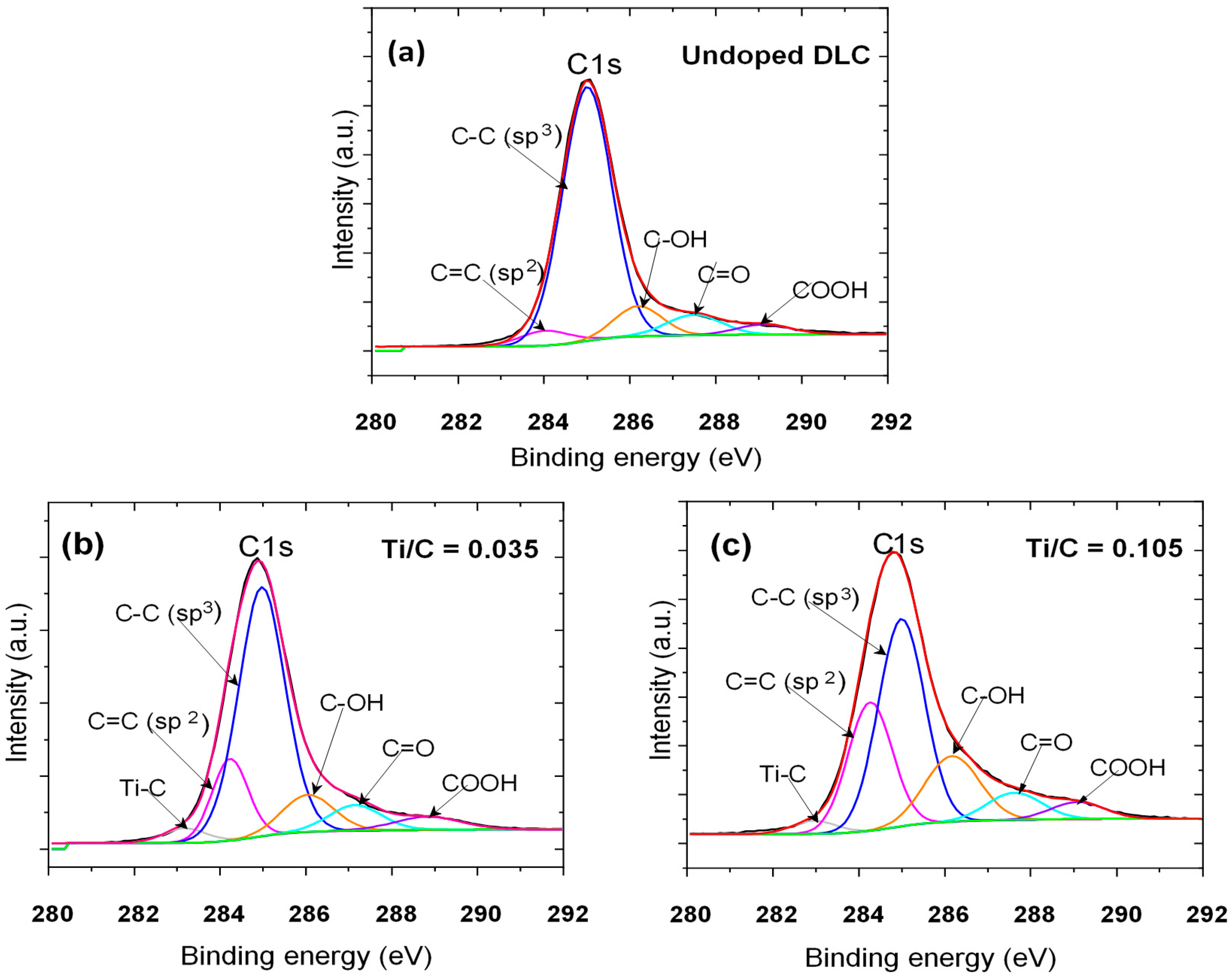

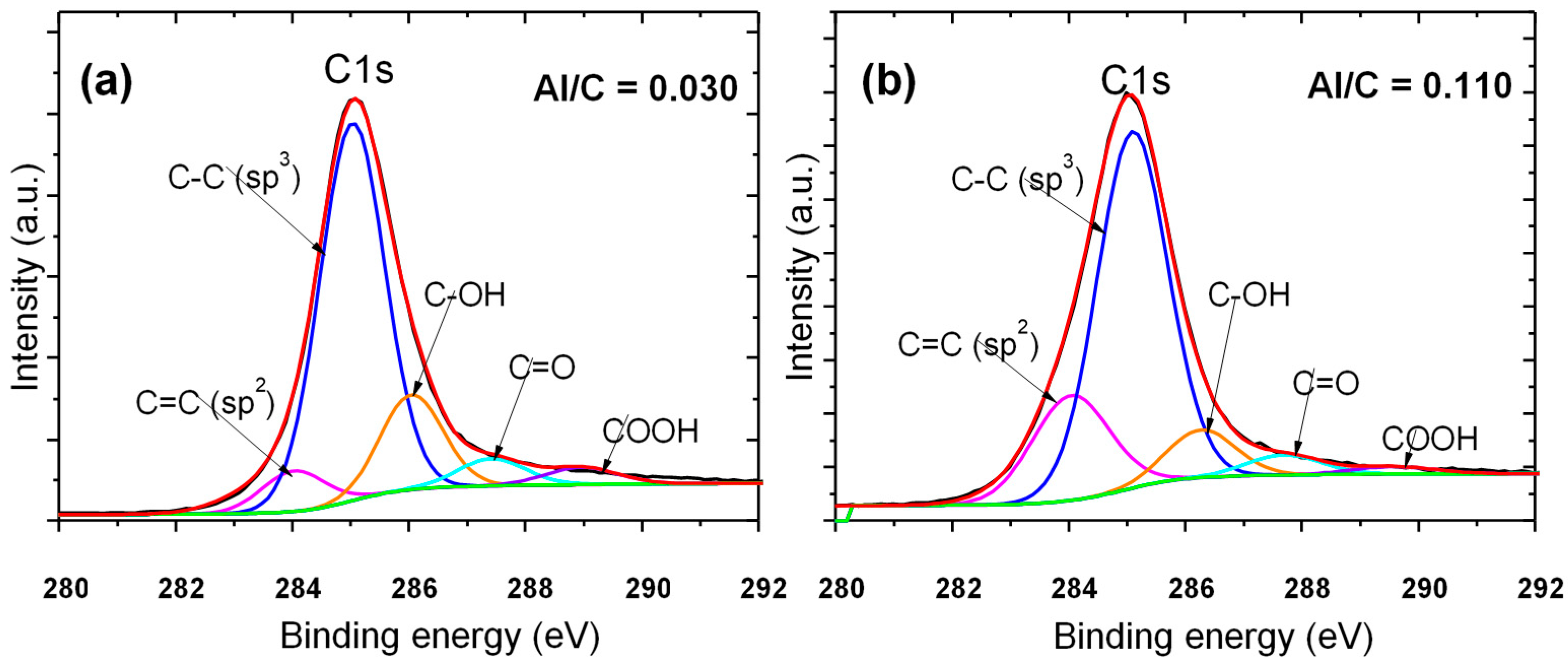
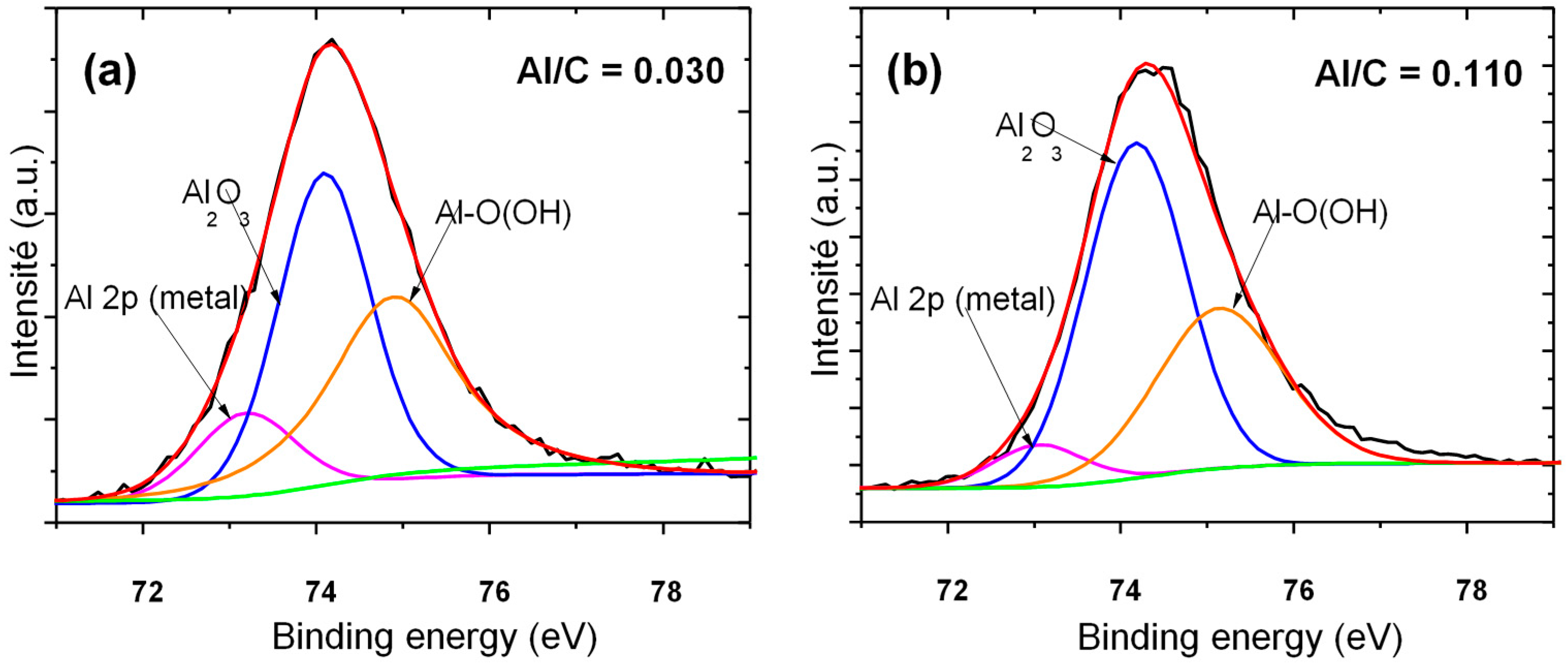
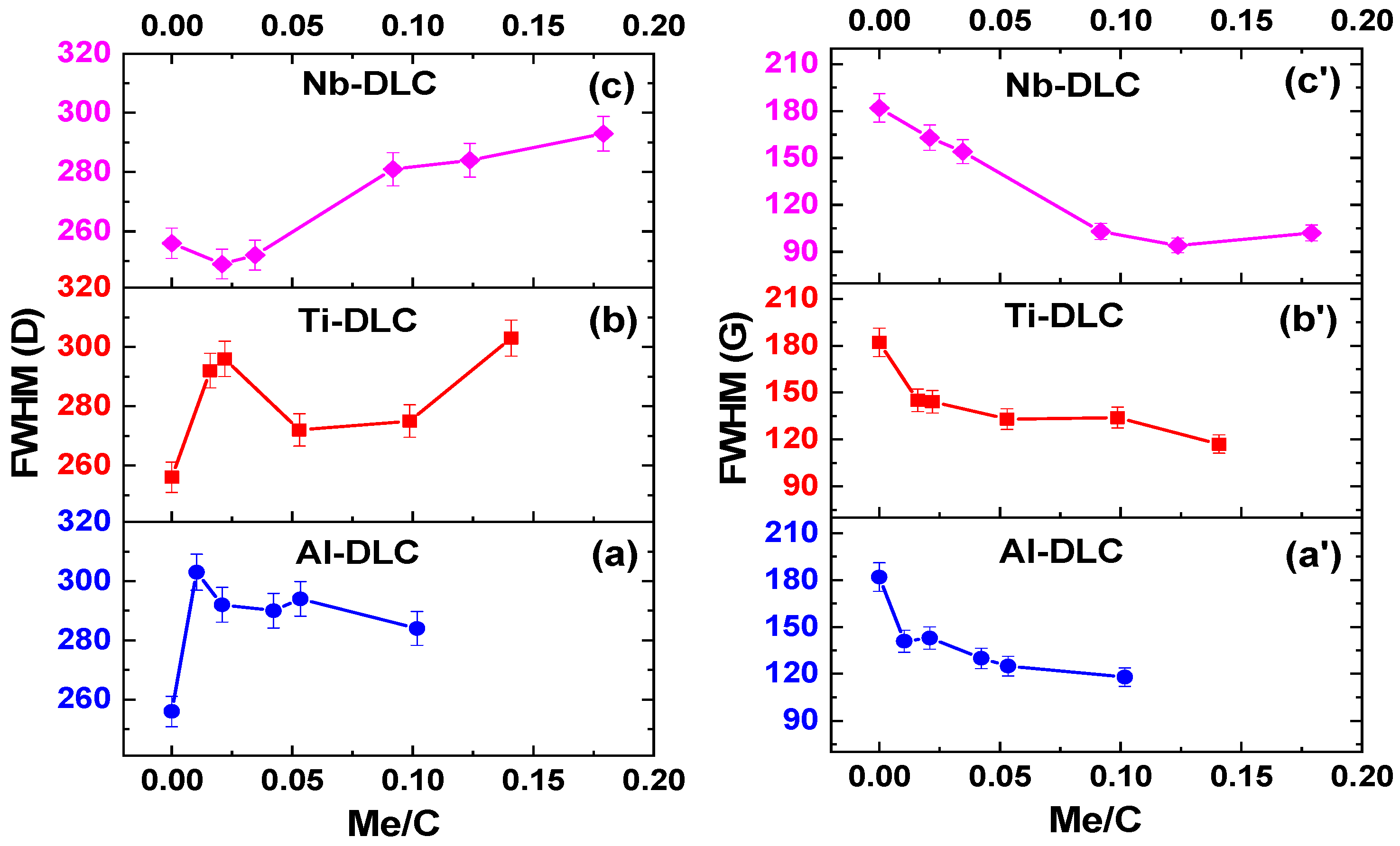
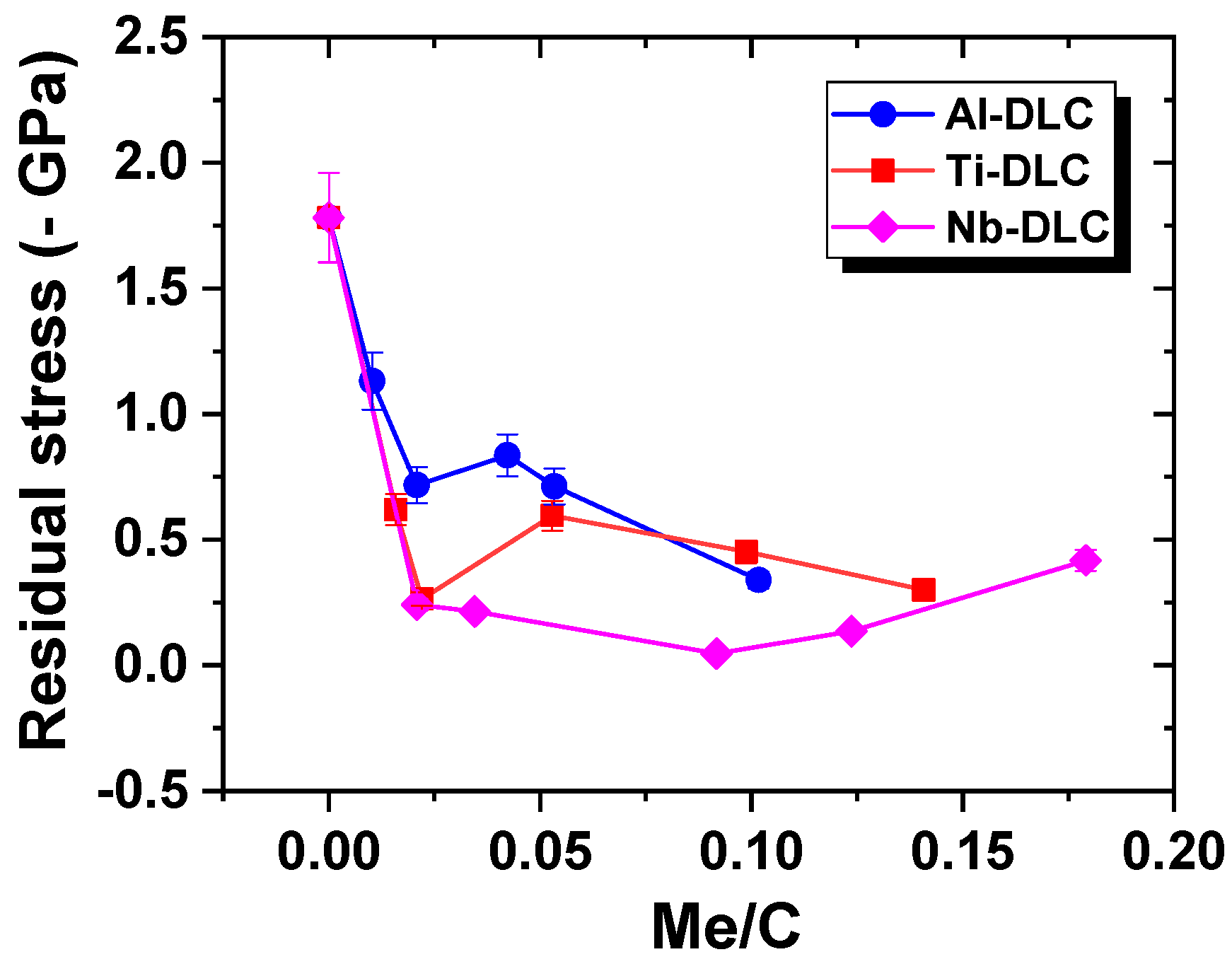

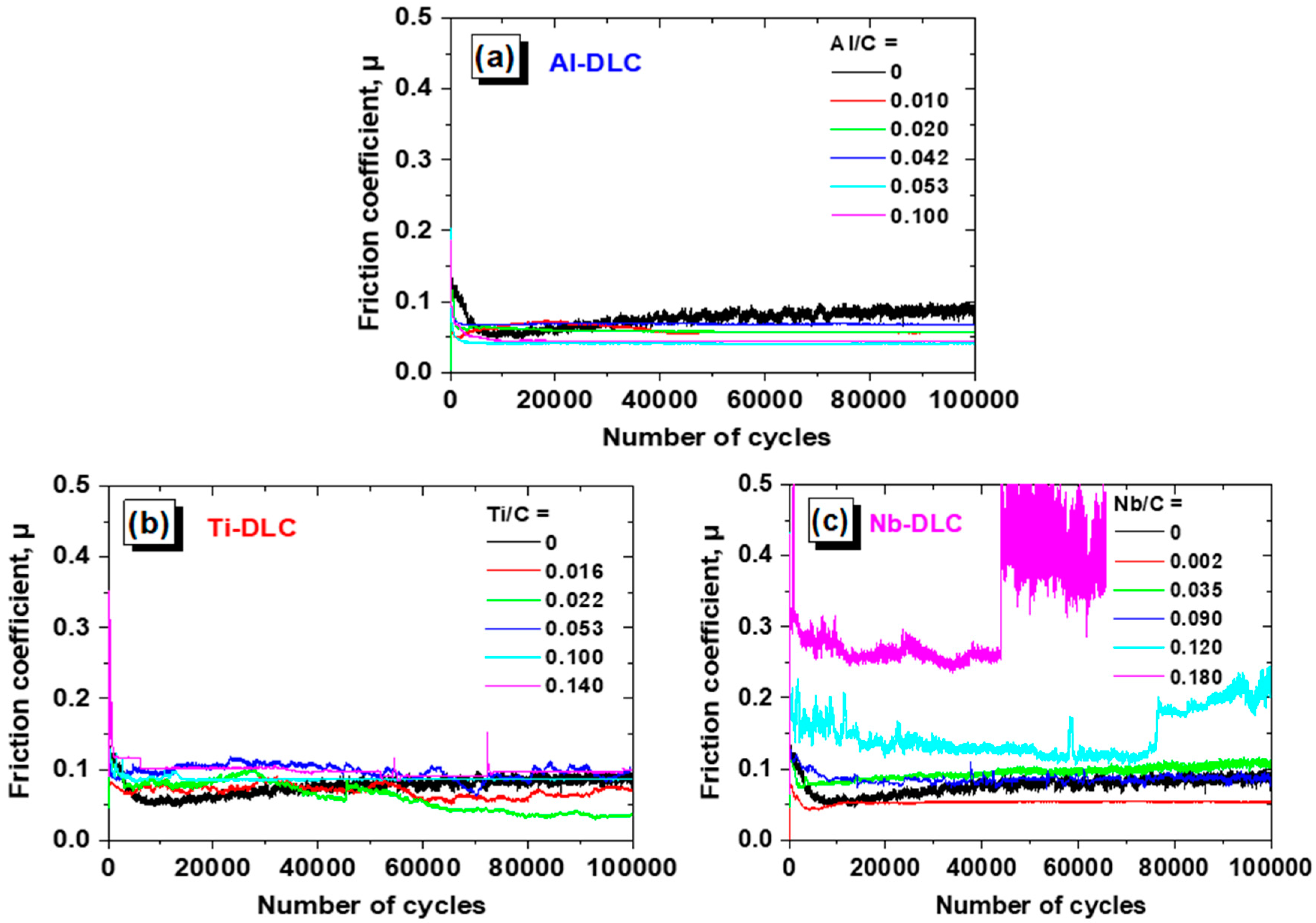
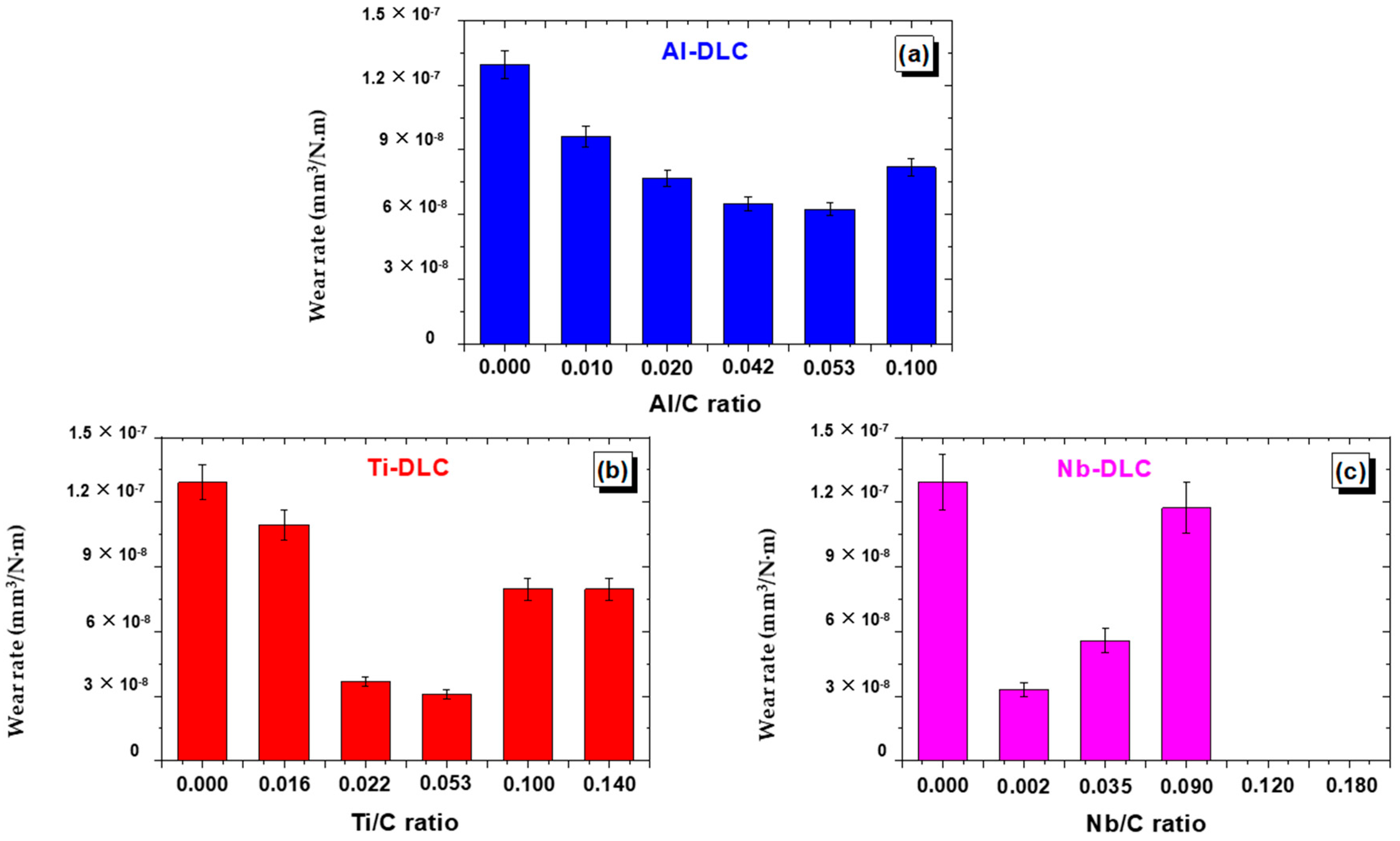
| Parameters | Cr Interlayer | Undoped DLC | Me-DLC Coatings |
|---|---|---|---|
| Power source | DC | RF (Bias) | DC (target) + RF (Bias) |
| Metal target | Cr | – | Al, Ti or Nb |
| DC current (A) | 1 | 0 | Al-DLC: 1.2–1.6 |
| Ti-DLC: 1.5–2.5 | |||
| Nb-DLC: 0.9–1.5 | |||
| RF Power (W) | 0 | 200 | 200 |
| Ar/H2/C2H2 gas flow rate (sccm) | 100/0/0 | 100/5/10 | 100/5/10 |
| Working pressure (Pa) | 1.5 | 4 | 4 |
| Thickness (µm) | 0.1 ± 0.02 | 3 ± 0.2 | 3 ± 0.2 |
| Substrate holder rotation (rpm) | 5 | ||
| Ball | Initial Hertz Pressure (Hertz Contact Stress) (GPa) | Sliding Distance (m) | Number of Cycles | Sliding Velocity (cm/s) | Normal Load (N) | Relative Humidity (%) | Temperature (°C) |
|---|---|---|---|---|---|---|---|
| Al2O3 | 1.5 | 2525 | 100,000 | 10 | 10 | 40–45 | 25–30 |
| Al-DLC Coatings | Current (A) | C (at.%) | Al (at.%) | Al/C |
| 1.20 | 97.3 | 1 | 0.010 | |
| 1.25 | 95.9 | 2 | 0.020 | |
| 1.30 | 94.7 | 4 | 0.042 | |
| 1.35 | 93.7 | 5 | 0.053 | |
| 1.40 | 89.8 | 9.13 | 0.100 | |
| Ti-DLC Coatings | Current (A) | C (at.%) | Ti (at.%) | Ti/C |
| 0.95 | 97.0 | 1.54 | 0.016 | |
| 1.00 | 96.0 | 2.11 | 0.022 | |
| 1.30 | 91.7 | 4.85 | 0.053 | |
| 1.50 | 88.9 | 8.78 | 0.100 | |
| 2.00 | 80.7 | 11.36 | 0.140 | |
| Nb-DLC Coatings | Current (A) | C (at.%) | Nb (at.%) | Nb/C |
| 0.70 | 96.7 | 2.02 | 0.021 | |
| 0.80 | 95.6 | 3.3 | 0.035 | |
| 0.90 | 91.6 | 8.4 | 0.091 | |
| 1.00 | 89.0 | 11.0 | 0.120 | |
| 1.30 | 84.8 | 15.2 | 0.180 |
© 2018 by the authors. Licensee MDPI, Basel, Switzerland. This article is an open access article distributed under the terms and conditions of the Creative Commons Attribution (CC BY) license (http://creativecommons.org/licenses/by/4.0/).
Share and Cite
Bouabibsa, I.; Lamri, S.; Sanchette, F. Structure, Mechanical and Tribological Properties of Me-Doped Diamond-Like Carbon (DLC) (Me = Al, Ti, or Nb) Hydrogenated Amorphous Carbon Coatings. Coatings 2018, 8, 370. https://doi.org/10.3390/coatings8100370
Bouabibsa I, Lamri S, Sanchette F. Structure, Mechanical and Tribological Properties of Me-Doped Diamond-Like Carbon (DLC) (Me = Al, Ti, or Nb) Hydrogenated Amorphous Carbon Coatings. Coatings. 2018; 8(10):370. https://doi.org/10.3390/coatings8100370
Chicago/Turabian StyleBouabibsa, Imane, Salim Lamri, and Frederic Sanchette. 2018. "Structure, Mechanical and Tribological Properties of Me-Doped Diamond-Like Carbon (DLC) (Me = Al, Ti, or Nb) Hydrogenated Amorphous Carbon Coatings" Coatings 8, no. 10: 370. https://doi.org/10.3390/coatings8100370
APA StyleBouabibsa, I., Lamri, S., & Sanchette, F. (2018). Structure, Mechanical and Tribological Properties of Me-Doped Diamond-Like Carbon (DLC) (Me = Al, Ti, or Nb) Hydrogenated Amorphous Carbon Coatings. Coatings, 8(10), 370. https://doi.org/10.3390/coatings8100370





